Research on the Magnetic Properties of High-Saturation Magnetically Induced Alloy Motors under Magnetocaloric Coupling
Abstract
:1. Introduction
2. Material Analysis and Testing
- In this experiment, the insulating coating was sprayed manually, resulting in an uneven thickness of the 1J22 surface coating.
- The 1J22 sample was sheared first and then annealed, so the effect of shear stress on 1J22 was minimal. However, traditional silicon steel is annealed first and then sheared, so the experimental results of traditional silicon steel were influenced by shear stress.
- There are many annealing methods for 1J22, and this paper only selects one of them. Therefore, the experimental results may be different from the results of other literature.
3. Magnetocaloric Coupling Experiments
3.1. Results and Analysis
3.2. Iron Loss Model Considering the Effects of Temperature
4. Finite Element Simulation of Electric motors
4.1. Electromagnetic Field Analysis
4.2. Temperature Field Analysis
5. Conclusions
- The iron loss trend of 1J22 material is consistent with that of traditional silicon steel and decreases with the increase in temperature. However, the loss of 1J22 is less sensitive to temperature. The loss of traditional silicon steel decreased the most at 1.1 T, with a decrease of 6.41%. The maximum loss change of 1J22 was 1.9 T, which decreased by 4.44%, and then the loss change rate gradually decreased; the loss change rate of 2.2 T was 2.23%.
- In the motor design process, the magnetic properties of the core material play a crucial role in the performance of the motor. Through experiments, it is found that the core loss of the 1J22 motor considering the influence of temperature can be reduced by 6.6% at most. With the increase in speed, the proportion of the high efficiency of the motor gradually increases.
- During the simulation of the motor temperature field, it was found that the motor temperature rise was improved using 110 °C and 120 °C material data. The temperature of the motor rises to 119.7 °C 6% longer than before. Therefore, when designing high-performance motors, it is necessary to consider the change trend of magnetic properties of core materials under the action of temperature, which can improve the calculation accuracy of the model, and increase the reliability of motor design.
Author Contributions
Funding
Institutional Review Board Statement
Informed Consent Statement
Data Availability Statement
Conflicts of Interest
References
- Zhang, Y.; McLoone, S.; Cao, W.P.; Qiu, F.; Gerada, C. Power loss and thermal analysis of a MW high speed permanent magnet synchronous machine. IEEE Trans. Energy Convers. 2017, 32, 1468–1478. [Google Scholar] [CrossRef]
- Ou, J.; Liu, Y.; Doppelbauer, M. Comparison Study of a Surface-Mounted PM Rotor and an Interior PM Rotor Made from Amorphous Metal of High-Speed Motors. IEEE Trans. Ind. Electron. 2021, 68, 9148–9159. [Google Scholar] [CrossRef]
- Chai, F.; Li, Z.; Ou, J.; Yu, Y. Torque analysis of high-speed switched reluctance motor with amorphous alloy core. In Proceedings of the 2020 International Conference on Electrical Machines (ICEM), Gothenburg, Sweden, 23–26 August 2020; pp. 2464–2468. [Google Scholar] [CrossRef]
- Fan, T.; Li, Q.; Wen, X. Development of a High Power Density Motor Made of Amorphous Alloy Cores. IEEE Trans. Ind. Electron. 2014, 61, 4510–4518. [Google Scholar] [CrossRef]
- Tanaka, I.; Nitomi, H.; Imanishi, K.; Okamura, K.; Yashiki, H. Application of High-Strength Nonoriented Electrical Steel to Interior Permanent Magnet Synchronous Motor. IEEE Trans. Magn. 2013, 49, 2997–3001. [Google Scholar] [CrossRef]
- Ou, J.; Liu, Y.; Breining, P.; Gietzelt, T.; Wunsch, T.; Doppelbauer, M. Experimental Characterization and Feasibility Study on High Mechanical Strength Electrical Steels for High-Speed Motors Application. IEEE Trans. Ind. Appl. 2021, 57, 284–293. [Google Scholar] [CrossRef]
- Zhang, H.; Zeng, L.; An, D.; Pei, R. Magnetic Performance Improvement Caused by Tensile Stress in Equivalent Iron Core Fabricated by High-Strength Non-Oriented Electrical Steel. IEEE Trans. Magn. 2022, 58, 8600105. [Google Scholar] [CrossRef]
- Elmen, G. Magnetic Material and Appliance. U.S. Patent 1,739,752, 17 December 1929. [Google Scholar]
- Pfeifer, F.; Raddeloff, C. Soft magnetic Fe–Ni and Fe–Co Al-loys—Some physical and mettallurgical aspects. J. Magn. Magn. Mater. 1980, 19, 190–207. [Google Scholar] [CrossRef]
- Matsuhara, M.; Sanada, M.; Morimoto, S.; Inoue, Y. Study of suitable motor structure for IPMSM with high flux density material. In Proceedings of the 2014 IEEE Energy Conversion Congress and Exposition (ECCE), Pittsburgh, PA, USA, 14–18 September 2014; pp. 2390–2395. [Google Scholar] [CrossRef]
- Wang, L.; Zhang, H.; Hu, A.; Li, Y.; Pei, R. Research on Torque Performance of a Traction Motor by Using Fe-Co-V Soft Magnetic Alloys. IEEE Trans. Magn. 2022, 58, 8203206. [Google Scholar] [CrossRef]
- Cossale, M.; Krings, A.; Soulard, J.; Boglietti, A.; Cavagnino, A. Practical investigations on cobalt–iron laminations for electrical machines. IEEE Trans. Ind. Appl. 2015, 51, 2933–2939. [Google Scholar] [CrossRef]
- White, J.H.; Wahl, V.C. Workable Magnetic Compositions Containing Principally Iron and Cobalt. U.S. Patent 1,862,559, 14 June 1932. [Google Scholar]
- Li, L. High temperature magnetic properties of 49% Co–2% V–Fe alloy. J. Appl. Phys. 1996, 79, 4578–4580. [Google Scholar] [CrossRef]
- Bozorth, R.M. Ferromagnetism; IEEE: New York, NY, USA, 1991. [Google Scholar]
- Yu, R.H.; Basu, S.; Ren, L.; Zhang, Y.; Parvizi-Majidi, A.; Unruh, K.; Xiao, J. High temperature soft magnetic materials: FeCo alloys and composites. IEEE Trans. Magn. 2000, 36, 3388–3393. [Google Scholar] [CrossRef]
- Chen, Q.; Yang, X. Calculation analysis of thermal loss and temperature field of in-wheel motor in micro-electric vehicle. J. Mech. Sci. Technol. 2014, 28, 3189–3195. [Google Scholar] [CrossRef]
- Tani, Y.; Daikoku, H.; Arita, M.; Nakano, M.; Yamaguchi, S.; Toide, Y. Magnetic power loss characteristics of non-oriented electrical steel sheets under stress. J. Magn. Soc. Jpn. 2006, 30, 196–200. (In Japanese) [Google Scholar] [CrossRef]
- Takahashi, N.; Miyagi, D. Effect of stress on iron loss of motor core. In Proceedings of the 2011 IEEE International Electric Machines & Drives Conference (IEMDC), Niagara Falls, ON, Canada, 15–18 May 2011; pp. 469–474. [Google Scholar] [CrossRef]
- Fujisaki, K.; Hirayama, R.; Kawachi, T.; Satou, S.; Kaidou, C.; Yabumoto, M.; Kubota, T. Motor core iron loss analysis evaluating shrink fitting and stamping by finite-element method. IEEE Trans. Magn. 2007, 43, 1950–1954. [Google Scholar] [CrossRef]
- Miyagi, D.; Maeda, N.; Ozeki, Y.; Takahashi, N. Estimation of iron loss in motor core with shrink fitting using FEM analysis. IEEE Trans. Magn. 2009, 45, 1704–1707. [Google Scholar] [CrossRef]
- Krings, A.; Mousavi, S.A.; Wallmark, O. Temperature influence of Ni-Fe steel laminations on the characteristics of small slotless permanent magnet machines. IEEE Trans. Magn. 2013, 49, 4064–4067. [Google Scholar] [CrossRef]
- Takahashi, N.; Morishita, M.; Miyagi, D.; Nakano, M. Examination of magnetic properties of magnetic materials at high temperature using a ring specimen. IEEE Trans. Magn. 2010, 46, 548–551. [Google Scholar] [CrossRef]
- Yamazaki, K.; Seto, Y. Iron loss analysis of interior permanent-magnet synchronous motors-variation of main loss factors due to driving condition. IEEE Trans. Ind. Appl. 2006, 42, 1045–1052. [Google Scholar] [CrossRef]
- Zhao, N.; Liu, W. Loss calculation and thermal analysis of surface-mounted PM motor and interior PM motor. IEEE Trans. Magn. 2015, 51, 8112604. [Google Scholar] [CrossRef]
- Ma, D.; Li, J.; Tian, B.; Zhang, H.; Li, M.; Pei, R. Studies on Loss of a Motor Stator Iron Core with High Silicon Electrical Steel Considering Temperature and Compressive Stress Factors. In Proceedings of the 2022 IEEE 5th International Electrical and Energy Conference (CIEEC), Nangjing, China, 27–29 May 2022; pp. 4243–4248. [Google Scholar] [CrossRef]
- Yu, G.; Huang, J.; Xiao, L.; Xu, Y.; Zou, J. Effect of High-Pressure Environment on Deep-Sea Permanent Magnet Synchronous Motors with Fe–Co–V Alloy. IEEE Trans. Magn. 2023, 59, 8204105. [Google Scholar] [CrossRef]
- Sourmail, T. Near equiatomic FeCo alloys: Constitution, mechanical and magnetic properties. Prog. Mater. Sci. 2005, 50, 816–880. [Google Scholar] [CrossRef]
- Persiano, A.I.C.; Rawlings, R.D. Effect of niobium additions on the structure and magnetic properties of equiatomic iron-cobalt alloys. J. Mater. Sci. 1991, 26, 4026–4032. [Google Scholar] [CrossRef]
- Gan, C.; Zhu, J. Study on the Rolling Process of 1J22 Soft Magnetic Alloy. Mater. Sci. Forum 2013, 745–746, 119–125. [Google Scholar] [CrossRef]
- Chen, J.; Wang, D.; Cheng, S.; Wang, Y.; Zhu, Y.; Liu, Q. Modeling of Temperature Effects on Magnetic Property of Nonoriented Silicon Steel Lamination. IEEE Trans. Magn. 2015, 51, 2002804. [Google Scholar] [CrossRef]
- Huang, Y.K.; Dong, J.N.; Zhu, J.G.; Guo, Y.G. Core loss modeling for permanent magnet motor based on flux variation locus and finite element method. IEEE Trans. Magn. 2012, 48, 1023–1026. [Google Scholar] [CrossRef]


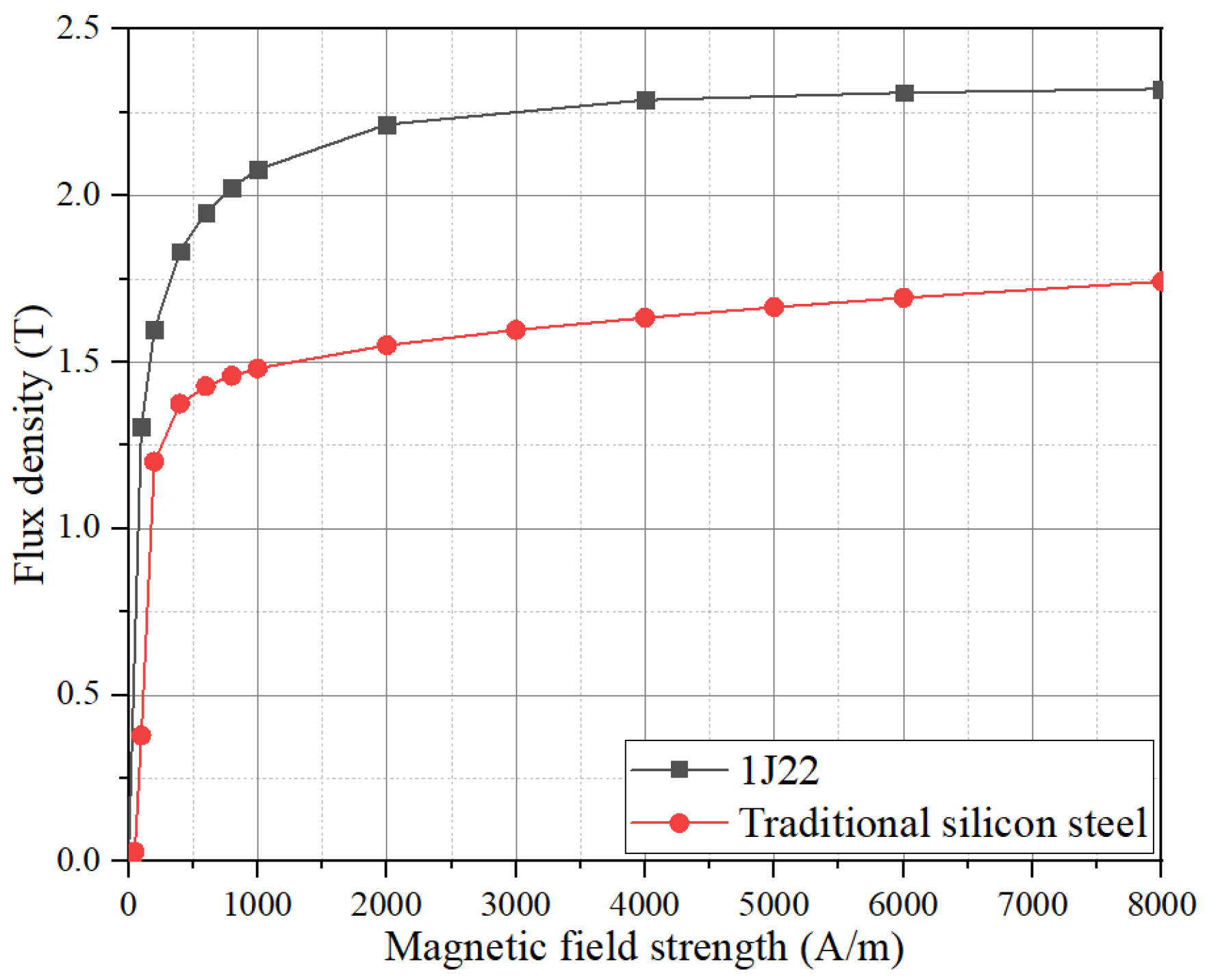

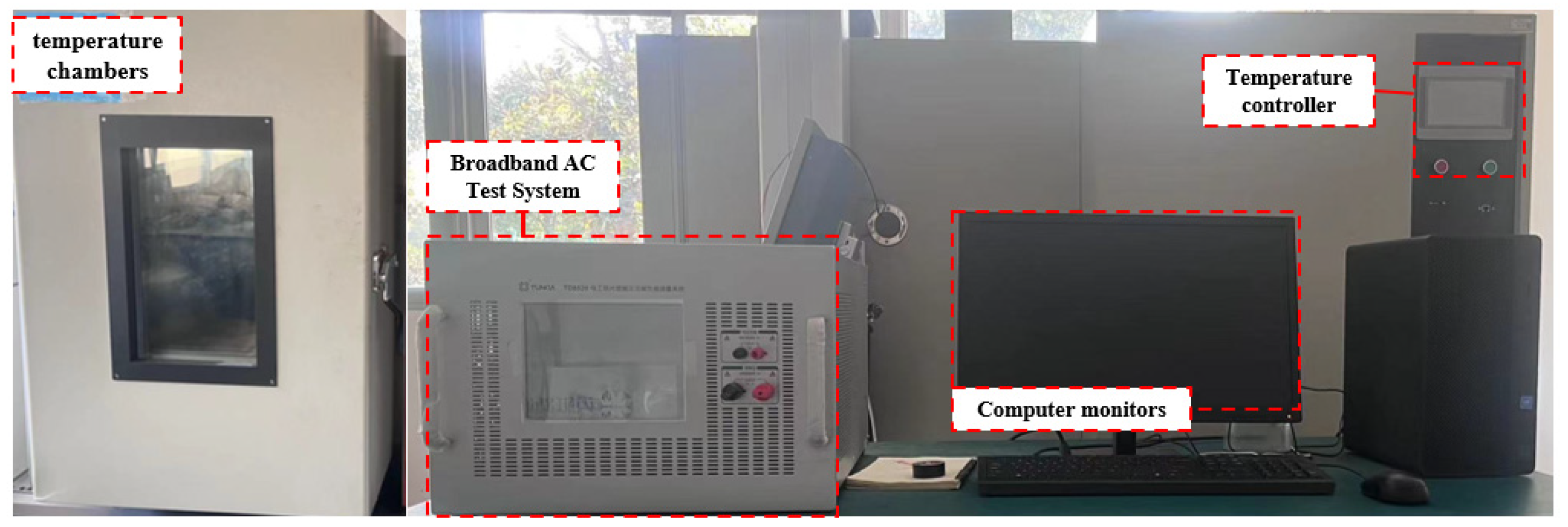

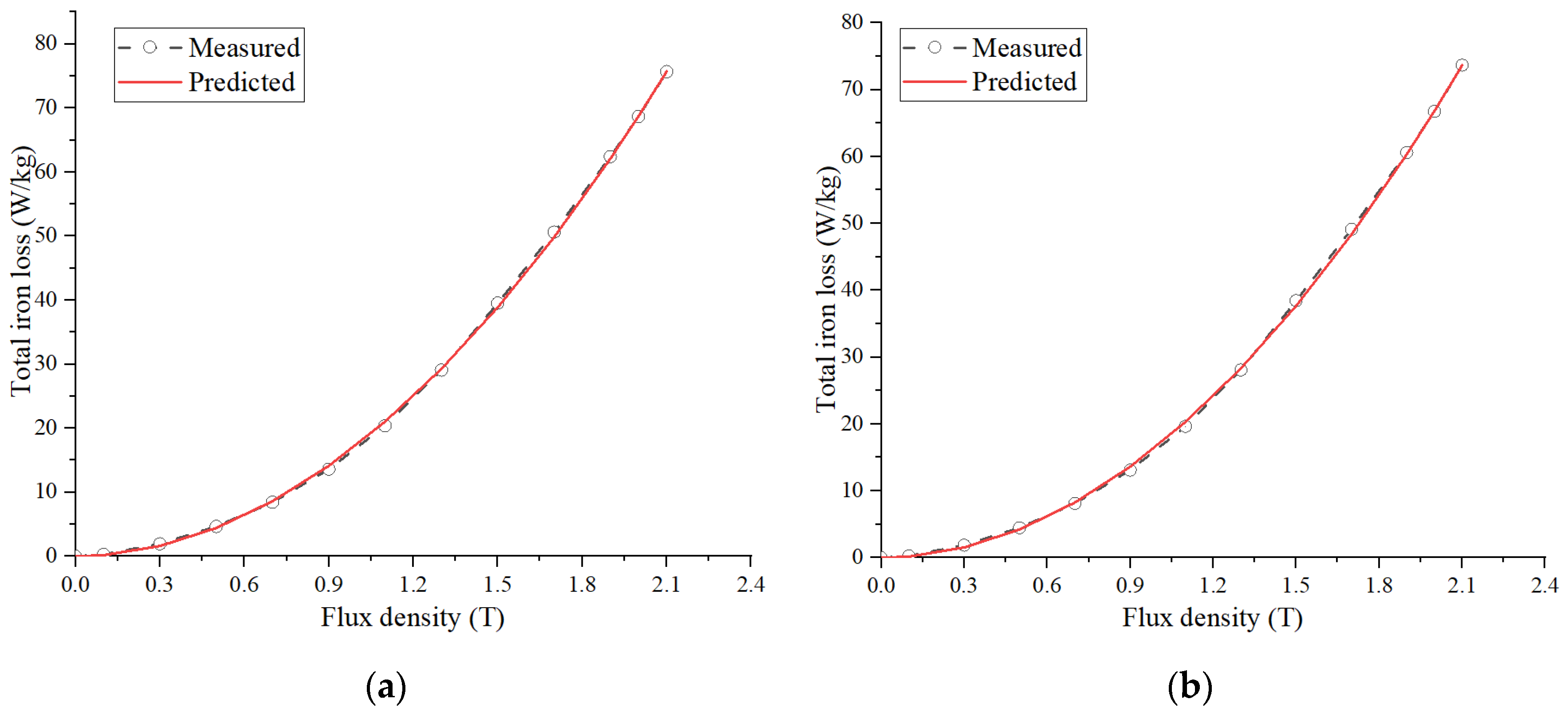
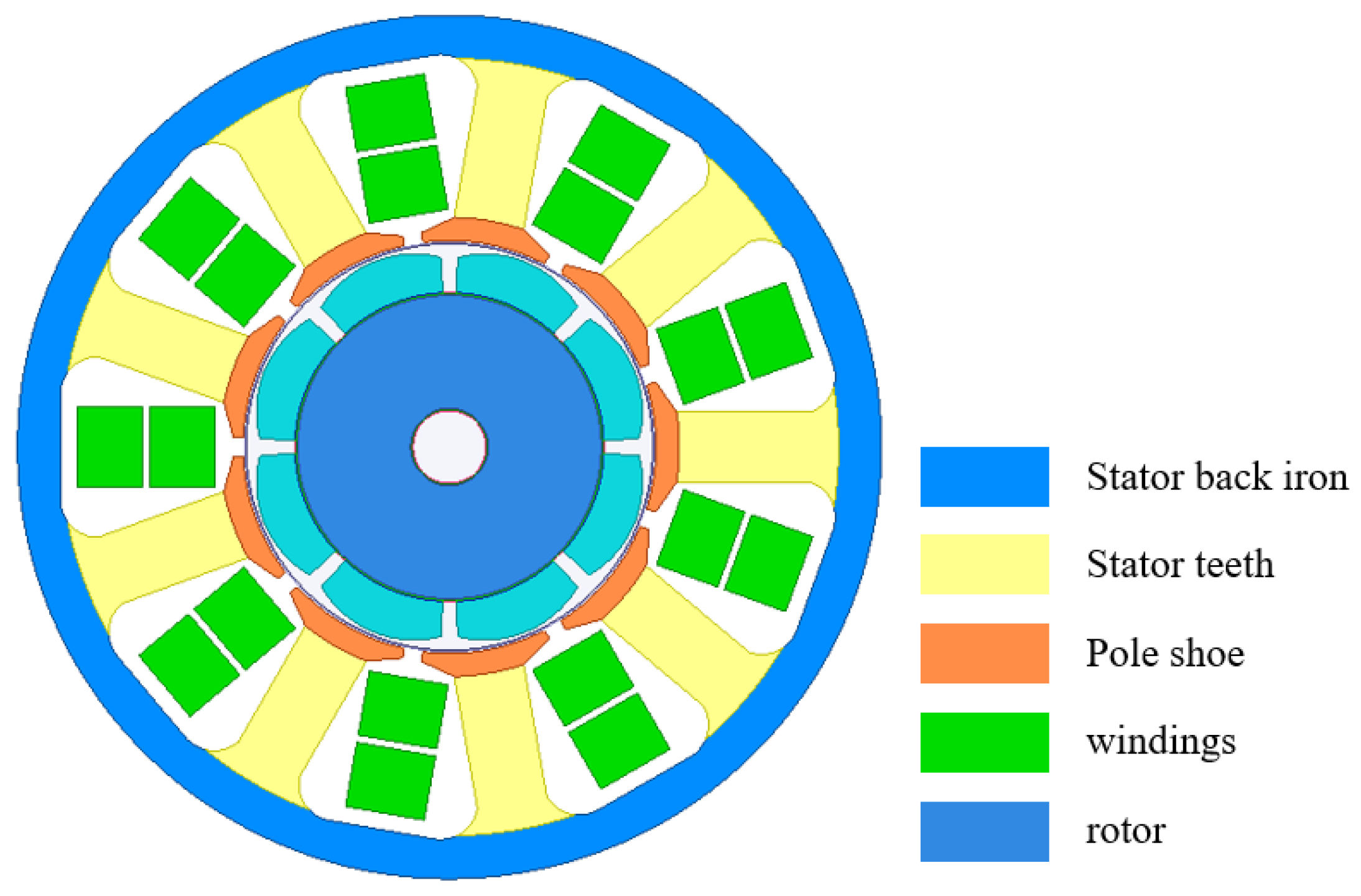

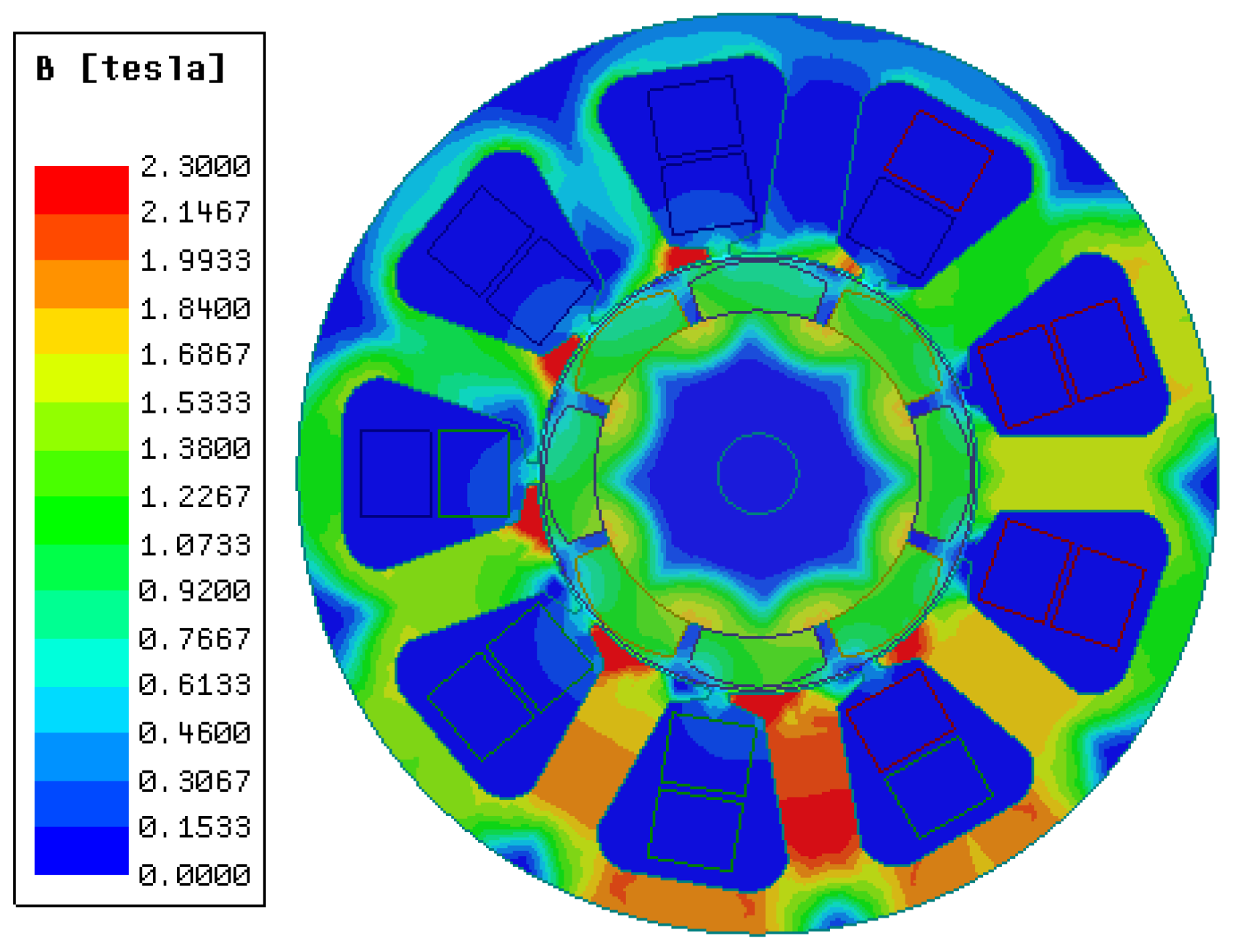
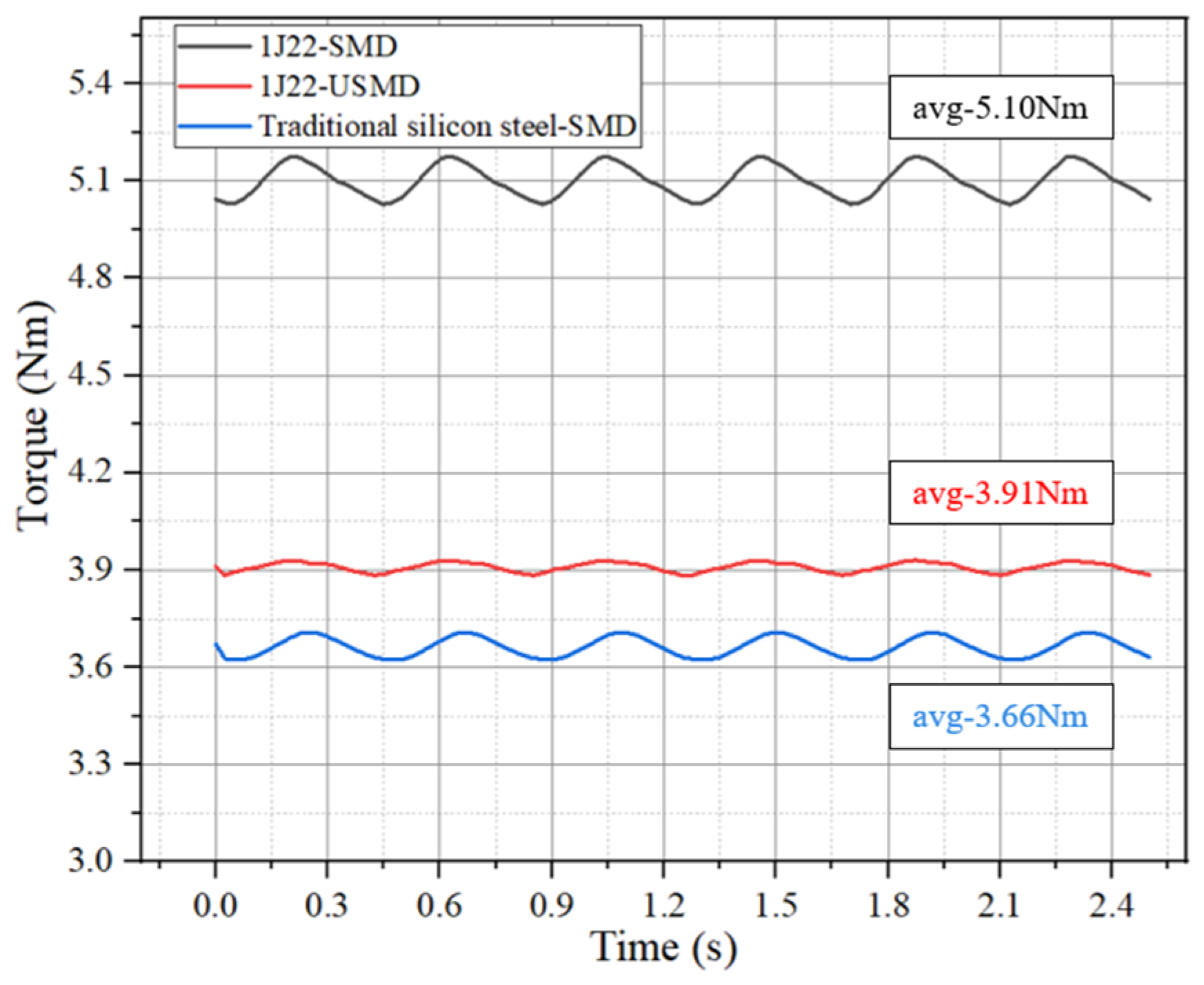
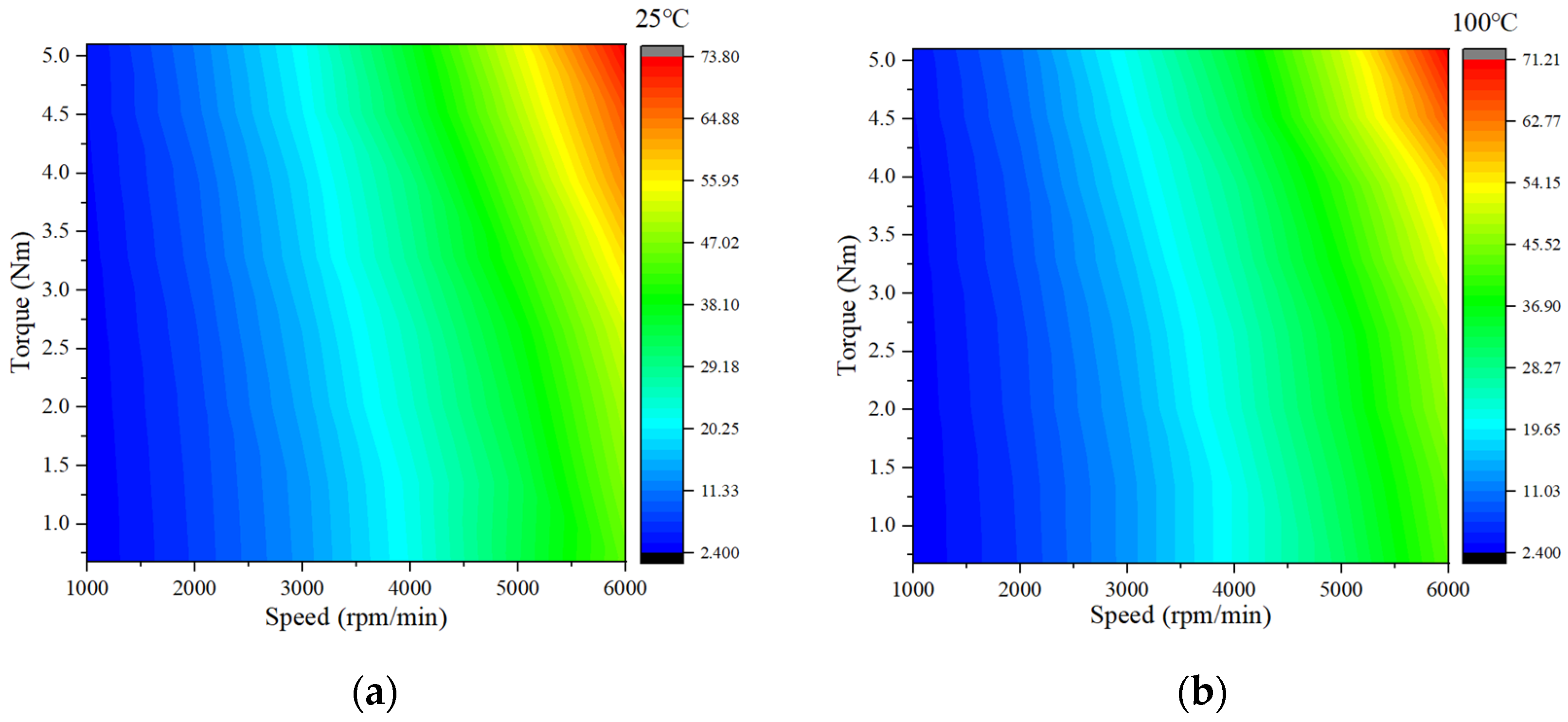

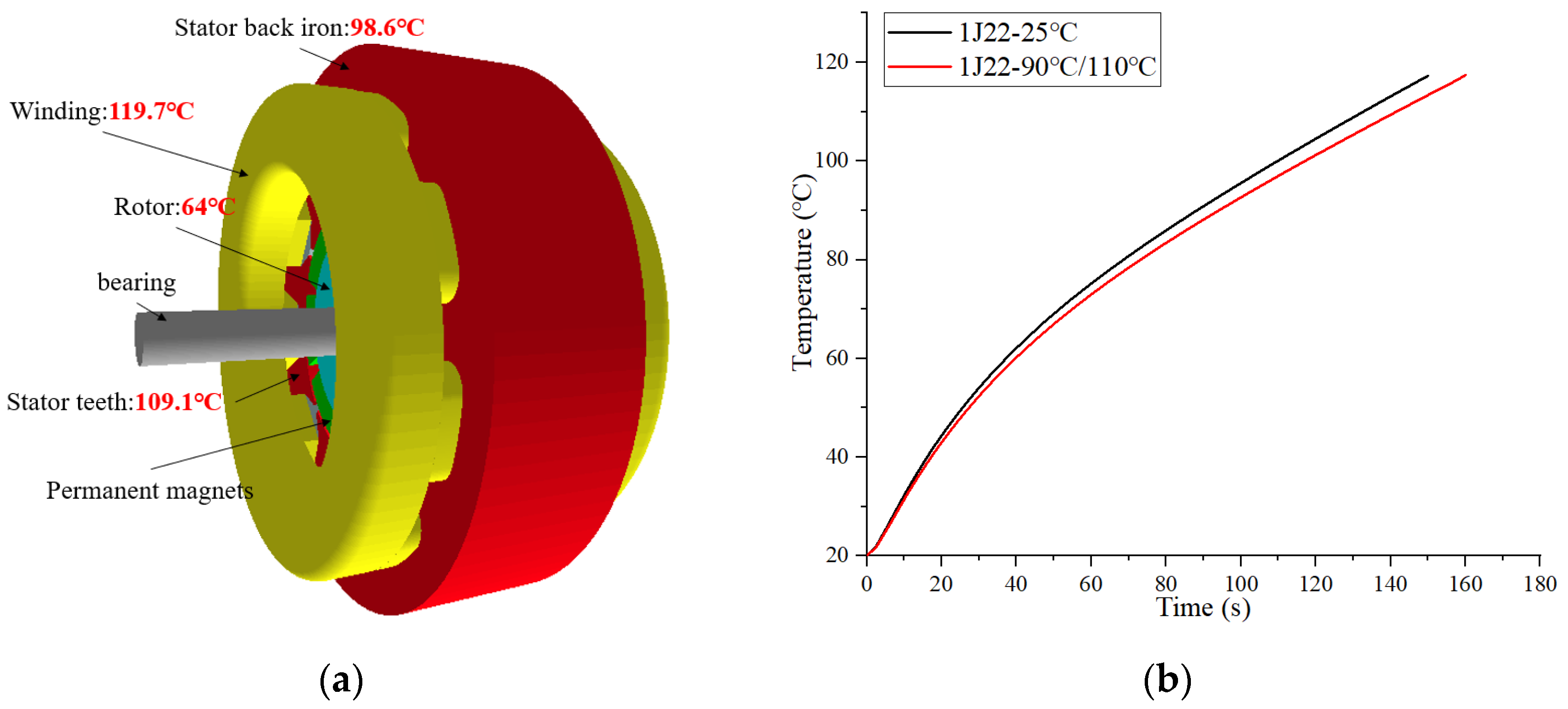
| Title | C | Mn | Si | Co | V | Other Trace Elements | Fe |
|---|---|---|---|---|---|---|---|
| 1J22 | ≤0.04% | ≤0.3% | ≤0.3% | 49~50% | 1~1.8% | ≤0.74% | Allowance |
| Traditional silicon steel | ≤0.02% | ≤0.3% | 3.2% | / | / | ≤0.08% | Allowance |
| Temperature | Kh | Kc |
|---|---|---|
| 0 °C | 0.004503564 | 0.00009990065 |
| 25 °C | 0.004476332 | 0.00009769490 |
| 50 °C | 0.004424972 | 0.00009716157 |
| 100 °C | 0.004424972 | 0.00009716157 |
| Title | Value | Title | Value |
|---|---|---|---|
| Outer diameter of stator | 92 | Inner diameter of the stator | 44 mm |
| Poles/slots | 8/9 | Length | 24 mm |
| Peak rotational speed | 6000 rpm/min | Peak torque | 3.6 Nm |
| Peak power | 2 kW | Peak current | 12 A |
| Cooling method | Natural cooling |
| Scheme | 1J22-25 °C | 1J22-100 °C |
|---|---|---|
| Efficiency > 85% | 71.86 | 72.22 |
| Efficiency > 90% | 47.50 | 48.72 |
| Highest efficiency | 93.56 | 93.75 |
Disclaimer/Publisher’s Note: The statements, opinions and data contained in all publications are solely those of the individual author(s) and contributor(s) and not of MDPI and/or the editor(s). MDPI and/or the editor(s) disclaim responsibility for any injury to people or property resulting from any ideas, methods, instructions or products referred to in the content. |
© 2024 by the authors. Licensee MDPI, Basel, Switzerland. This article is an open access article distributed under the terms and conditions of the Creative Commons Attribution (CC BY) license (https://creativecommons.org/licenses/by/4.0/).
Share and Cite
Li, J.; Li, Z.; Li, Y.; Ge, J.; Li, Y.; Zeng, L.; Pei, R. Research on the Magnetic Properties of High-Saturation Magnetically Induced Alloy Motors under Magnetocaloric Coupling. Materials 2024, 17, 1274. https://doi.org/10.3390/ma17061274
Li J, Li Z, Li Y, Ge J, Li Y, Zeng L, Pei R. Research on the Magnetic Properties of High-Saturation Magnetically Induced Alloy Motors under Magnetocaloric Coupling. Materials. 2024; 17(6):1274. https://doi.org/10.3390/ma17061274
Chicago/Turabian StyleLi, Jun, Zhiye Li, Yulin Li, Jiahao Ge, Yuxiao Li, Lubin Zeng, and Ruilin Pei. 2024. "Research on the Magnetic Properties of High-Saturation Magnetically Induced Alloy Motors under Magnetocaloric Coupling" Materials 17, no. 6: 1274. https://doi.org/10.3390/ma17061274






